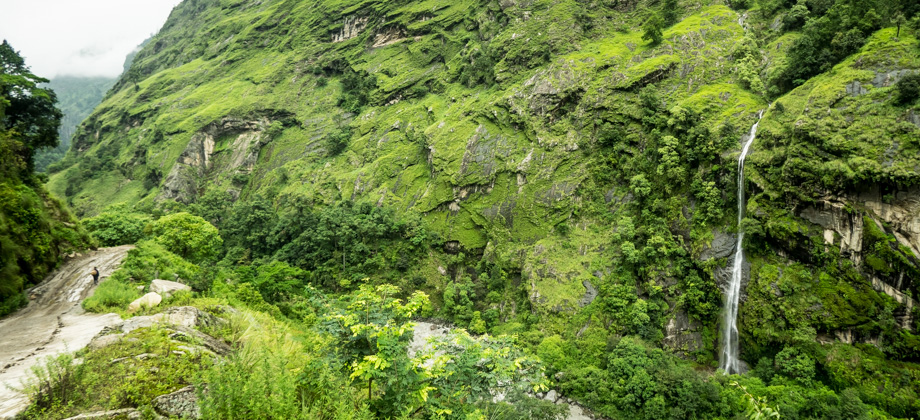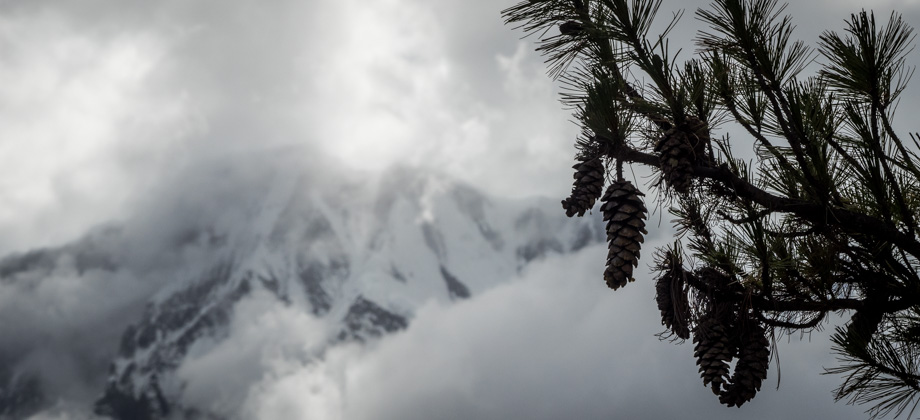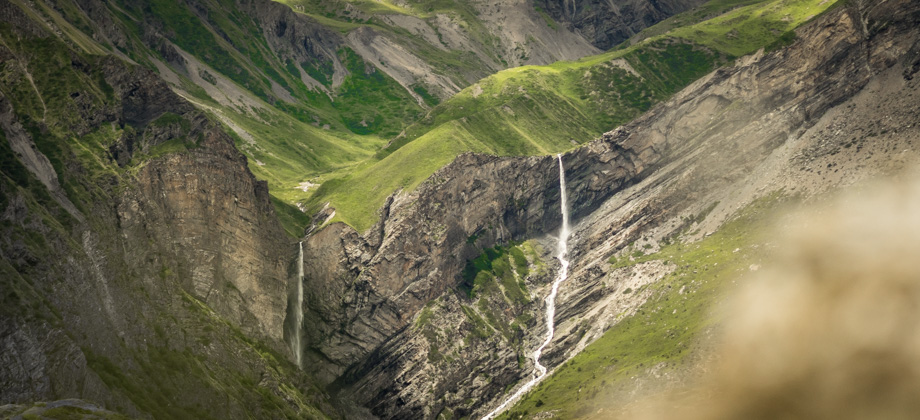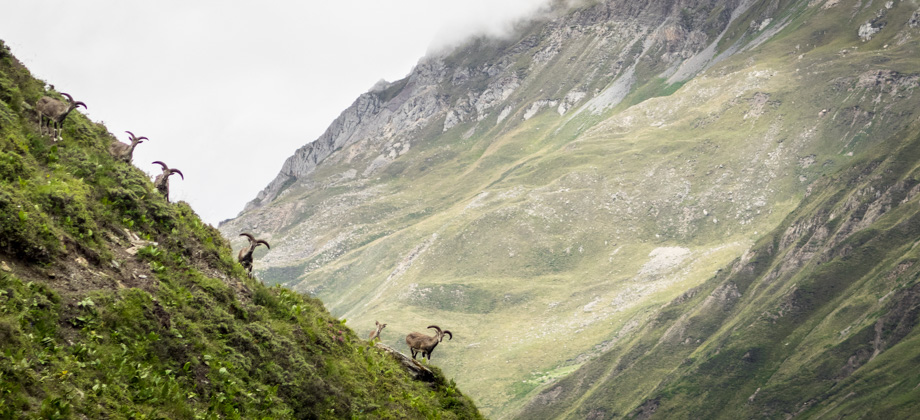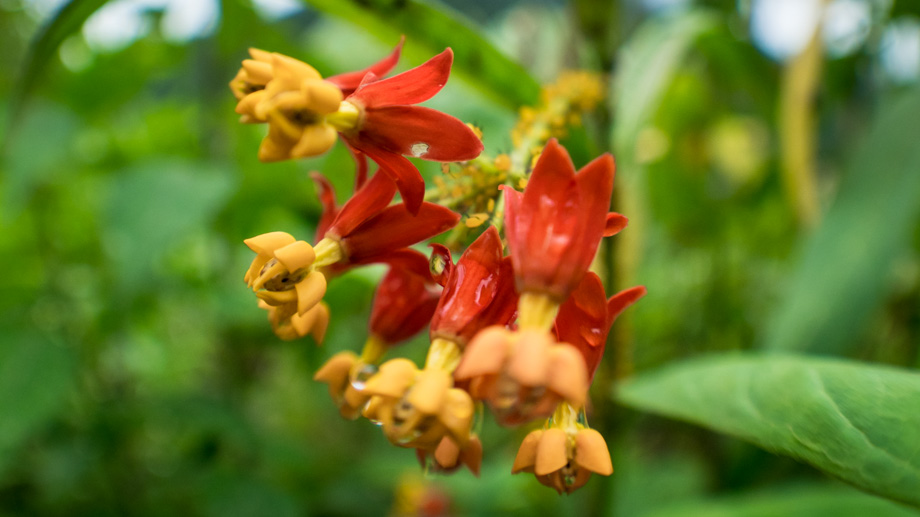ACT Day 01 - Ngadi to Srichaur
Setting Off

Rupesh, the owner of the homestay, had been such a delightful host the
previous day that we decided to purchase breakfast from him that morning instead of eating our own. We ended up chatting with him for quite a while, whilst eating our breakfast of Tibetan bread with honey (
NPR280), and so began the first day of our trek a little later than we had originally planned. Rupesh had told us about a
mandir up on the hill nearby the local school, and had then proceeded to walk with us to both show us the turnoff that lay up the road from his homestay

, as well as the bridge that we then had to cross.
He handed us several bananas as we said our farewells, before walking up the stone stairwell that lay just after the bridge. Lush green paddy fields
(Oryza sativa) appeared over on the other side as we ascended the rise towards the large pipal tree
(Ficus religiosa) that lay atop the crest. The path veered to the right after that, and along an alley of sorts that was fringed with fern and flanked by a moss-covered wall. The alley ran parallel to the river that we had just crossed, that drained into the mighty Marsyangdi river behind us.
 The bridge and the pipal tree (Ficus religiosa)
The bridge and the pipal tree (Ficus religiosa)

The views that surrounded us were enchanting--mist hugged the distant mountains in the background, whilst vibrant paddy fields in the foreground added contrasting layers to the scenery. The constant sound of the thundering river was a poignant reminder of the raw power of nature, and that we needed to treat it with the utmost respect. The trail eventually began to wind back down to Ngadi town (
elevation : 930 m), before merging back onto the road that was lined with guesthouses. We came across the red and white
NATT markers that pointed the way to the 'Lalupate Trail', which is the Nepali name for the poinsettia flower
(Euphorbia pulcherrima).
By then, almost an hour had passed and we had only covered 1.5 kilometres, which was less than 1% of the distance that we were to cover over the next few weeks.
The trail led through another alley for a few hundred metres, passing several guesthouses, before emerging back out and right before a
30MW hydropower station. We continued along the road and veered right instead of crossing the bridge right in-front of us. The trail made its way around to some settlements and a long suspension bridge that was easily 50 metres above the torrential river below. The road from here on seemed to be almost completely devoid of vehicles; in fact, only two 4WD vehicles passed us along the way. As a result, the dust that would usually have been churned up by passing vehicles was completely absent. The road ran parallel to the grey Marsyangdi river, which was much wider and a lot calmer than further downstream, and led to a massive 'signpost' that had been painted on the rocks, where we turned right and began to ascend the hill.

This next segment was fairly long. The ascent brought us up and above the river, from where we were able to see the dirt road slicing through the slopes on the other side. Waterfalls could also be seen plunging for hundreds of metres down the cliffs to the left, whereas just up ahead, the large and isolated Bahundanda hill dominated the view. The village of Bahundanda (
elevation : 1310 m) could also be seen nestled on the ridge to the right of the peak. The elevation difference made it clear to us then that there was quite a bit of climbing that lay in store for us just up ahead.
 A male scarlet minivet (Pericrocotus speciosus) seen through the foliage
A male scarlet minivet (Pericrocotus speciosus) seen through the foliage


 The views that surrounded us were enchanting--mist hugged the distant mountains in the background, whilst vibrant paddy fields in the foreground added contrasting layers to the scenery. The constant sound of the thundering river was a poignant reminder of the raw power of nature, and that we needed to treat it with the utmost respect. The trail eventually began to wind back down to Ngadi town (elevation : 930 m), before merging back onto the road that was lined with guesthouses. We came across the red and white NATT markers that pointed the way to the 'Lalupate Trail', which is the Nepali name for the poinsettia flower (Euphorbia pulcherrima).
By then, almost an hour had passed and we had only covered 1.5 kilometres, which was less than 1% of the distance that we were to cover over the next few weeks.
The trail led through another alley for a few hundred metres, passing several guesthouses, before emerging back out and right before a 30MW hydropower station. We continued along the road and veered right instead of crossing the bridge right in-front of us. The trail made its way around to some settlements and a long suspension bridge that was easily 50 metres above the torrential river below. The road from here on seemed to be almost completely devoid of vehicles; in fact, only two 4WD vehicles passed us along the way. As a result, the dust that would usually have been churned up by passing vehicles was completely absent. The road ran parallel to the grey Marsyangdi river, which was much wider and a lot calmer than further downstream, and led to a massive 'signpost' that had been painted on the rocks, where we turned right and began to ascend the hill.
The views that surrounded us were enchanting--mist hugged the distant mountains in the background, whilst vibrant paddy fields in the foreground added contrasting layers to the scenery. The constant sound of the thundering river was a poignant reminder of the raw power of nature, and that we needed to treat it with the utmost respect. The trail eventually began to wind back down to Ngadi town (elevation : 930 m), before merging back onto the road that was lined with guesthouses. We came across the red and white NATT markers that pointed the way to the 'Lalupate Trail', which is the Nepali name for the poinsettia flower (Euphorbia pulcherrima).
By then, almost an hour had passed and we had only covered 1.5 kilometres, which was less than 1% of the distance that we were to cover over the next few weeks.
The trail led through another alley for a few hundred metres, passing several guesthouses, before emerging back out and right before a 30MW hydropower station. We continued along the road and veered right instead of crossing the bridge right in-front of us. The trail made its way around to some settlements and a long suspension bridge that was easily 50 metres above the torrential river below. The road from here on seemed to be almost completely devoid of vehicles; in fact, only two 4WD vehicles passed us along the way. As a result, the dust that would usually have been churned up by passing vehicles was completely absent. The road ran parallel to the grey Marsyangdi river, which was much wider and a lot calmer than further downstream, and led to a massive 'signpost' that had been painted on the rocks, where we turned right and began to ascend the hill.
 This next segment was fairly long. The ascent brought us up and above the river, from where we were able to see the dirt road slicing through the slopes on the other side. Waterfalls could also be seen plunging for hundreds of metres down the cliffs to the left, whereas just up ahead, the large and isolated Bahundanda hill dominated the view. The village of Bahundanda (elevation : 1310 m) could also be seen nestled on the ridge to the right of the peak. The elevation difference made it clear to us then that there was quite a bit of climbing that lay in store for us just up ahead.
This next segment was fairly long. The ascent brought us up and above the river, from where we were able to see the dirt road slicing through the slopes on the other side. Waterfalls could also be seen plunging for hundreds of metres down the cliffs to the left, whereas just up ahead, the large and isolated Bahundanda hill dominated the view. The village of Bahundanda (elevation : 1310 m) could also be seen nestled on the ridge to the right of the peak. The elevation difference made it clear to us then that there was quite a bit of climbing that lay in store for us just up ahead.




